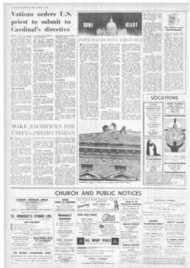Page 10, 11th February 1966
Page 10

Report an error
Noticed an error on this page?If you've noticed an error in this article please click here to report it.
Tags
Share
Related articles
Those Troubled Days In San Marino
Pope No Longer Prisoner Of Vatican
A Day In The Life Of The Pope
The Pope Still In Good Health
By Alan Mcelwain S Oon After His Election Last June, Pope
POPE' S HOUSING TROUBlr,F
EVEN a 20th century Pope 121 can have his housing troubles, if a report currently prevalent but, as ever, unconfirmed in the Vatican is correct. Pope Paul, the story goes, may have to move from his Apostolic Palace in the Vatican to the palace attached to the Basilica of St. John Lateran, his "cathedral" as Bishop of Rome.
For some months, workmen have been building a terrace outside the Pope's apartments in the Apostolic Palace. where he will be able to get at least a little recreation in the open air-something his doctors have been insisting upon. Normally, Popes take their recreation by walking in the Vatican Gardens, but Pope Paul has set himself such a gruelling daily routine that he has found this almost impossible.
Now, it is reported, the architect and engineers in charge of the terrace job above the top floor of the Apostolic Palace have discovered some rather ominous cracks in the walls of the lfith century building, and restoration work could take some time. It could also, presumably, produce quite a lot of noise and general inconvenience.
So, the report has it, the logical thing would be for him to move to the Lateran, which is some distance from the Vatican, on the other side of town, The Lateran itself has been undergoing extensive exterior and interior renovations a n d , inside, is still in the hands of workmen.
On orders of the late Pope John, the contents of an old museum attached to the Lateran were transferred to the Vatican, and the Vicariate, through which the Rome diocese is governed, is to be transferred to the Lateran from overcrowded premises in the heart of the city.
The Basilica of St. John Lateran has special significance for the entire Catholic world. It is the head of all Catholic churches.
The adjoining palace was the home of Popes for 1,000 years. They lived there until their succession to Avignon in 1309. The palace as it is now known was built as a summer residence by Pope Sixtus V, who reigned from 1585 to 1590.
It also gained a special place in modern history when, on February II, 1929, Dictator Benito Mussolini, for the Italian State, and Cardinal Pietro Gasparri, for the Holy See, signed in the Lateran the Concordat which ended the long Church-State dispute and established the sovereignty of Vatican City. That is how it has come to be known as the Lateran Treaty.
It is now being hinted that the Lateran Palace may also be the headquarters of the international Senate (or Synod) of bishops who are to aid Pope Paul in the direct government of the Church.
THERE IS SOME surprise at the Vatican over the move-to-the-Lateran suggestion. The view is taken that only a real emergency would send the Pope far from the Vatican, and especially his Secretariat of State, its nerve centre, which is becoming increasingly important in these days of international crises.
It is also felt that if the Pope were compelled to move from his own apartments, it should be reasonably simple to find him temporary accommodation within Vatican City itself.
Two floors of the commodious Governor's Palace, for instance, are unoccupied. Admittedly they need renovating, but this could perhaps be accomplished with no more trouble than would be involved in preparing the 1.ateran Palace for Pope Paul's occupancy.
What is more, there is also the "modernised" famous old tower which Pope John had converted into a summer home. He planned to use it to escape Rome's fierce summer heat instead of having to leave the city for the papal summer villa at Castelgandolfo, about 20 miles outside Rome. However, Pope John died before he got round to occupying the tower, and it has remained unoccupied ever since.
in any case, if Pope Paul does go to the Lateran, it will not be until next autumn, after he has had his annual spell at Castelgandolfo. And, of course, he could even prolong his stay there while work on the Apostolic Palace was completed.
The Lateran Palace adjoins the great Piazza San Giovanni, which swarms with traffic, I trust that if Pope Paul does go over there, the palace's windows will be insulated against sound. The noise in those parts is shattering.
"SACRISTANS UNITE!" is the watchword of Italy's 17,000 church functionaries who think they are getting a pretty raw deal in a country where Catholicism is the State religion.
The sacristans held their second national conference recently, and 50 delegates, in the plainest possible chant,
ss,„ ro, na racid nthoale thieiprroptreo-c,
tion. Priests get State allowances and pensions, but the sacristans get nothing.
They are now pressing for official recognition, pins health insurance and pension schemes on the same basis as Italian workers.
FOLLOWING GRAVE scandals involving members of the Capuchin Order in Italy, the conduct of its Italian monasteries is being quietly investigated by an Apostolic Visitor appointed by Pope Paul, Vatican sources say. The investigator is Archbishop Andrea Pangrazio, of Gorizia. North Italy.
Last October, a Capuchin friar, Fr. Antonio Corsi, was sentenced to two years and eight months' gaol for his part in a cigarette smuggling racket, which came to tight after more than £20,000worth of contraband cigarettes had been found in the grounds of a Capuchin monastery at Albano, in the hills outside Rome. Also found was the dead body of
a man run over by a truck which bad transported the cigarettes.
This case got the same sensational headline treatment as an earlier one in which three Capuchin friars were convicted of assisting Mafia thugs in a reign of terror, blackmail, extortion and killing in Mazzarino, Sicily. The friars were each sentenced to 13 years' gaol, but an appeals court then ordered a new trial, still to take place. Meantime, one of the friars, aged 85, has died.
This sort of thing brings into disrepute an entire Order, which, since its foundation in 1525, has produced splendid priests and also its share of saints. One of the Church's largest Orders, it now has about 16.000 members, more than one-third of whom are in Italy.
It has been alleged that the scandals in Italy stern from laxly-run monasteries and a tendency in some places to admit as members men with no real vocation to the religious life. At any rate, Archbishop Pangrazio is reported to have been instructed to look specifically into possible changes in the selection and training of candidates.
blog comments powered by Disqus











